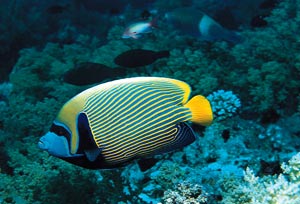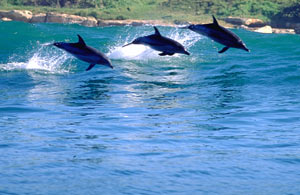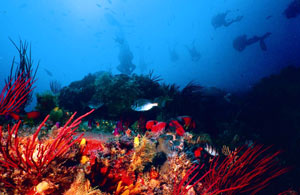Diving in Southern Africa
South Africa has a 3,000km coastline
so there are hundreds of dive sites and good snorkelling spots. But, even
more interesting, there's loads of variety, ranging from the icy kelp forests
off Cape Town to the tropical coral reefs off Sodwana Bay in KwaZulu-Natal.
Diving is big in South Africa with dive shops in almost every town of reasonable
size - even inland. In fact, diving is not restricted to our gorgeous coastline
- there is some really interesting freshwater diving, as well. There is
a large technical diving fraternity, and you will find nitrox fills in
most of the more developed dive destinations, and tri-mix at a few. Although
there are a couple of relatively shallow inland dives near Johannesburg,
most of the inland dives are deep, and at altitude, and some are in caves,
so they tend to attract mostly techies.
 There
are good snorkelling opportunities in most of the coastal areas, but it's
only in the warm sub-tropical waters of Maputaland and Mozambique
that it is really user-friendly. There
are good snorkelling opportunities in most of the coastal areas, but it's
only in the warm sub-tropical waters of Maputaland and Mozambique
that it is really user-friendly.
The West
Coast is not big on diving, but there is some good snorkelling
in the rather chilly Langebaan Lagoon, and in the calm, cold waters off
the Cape Columbine Nature Reserve. Most people, however, only put their
heads underwater here to take out crayfish - on snorkel, and with a permit.
Cape
Town is a great diving destination, but it's not for weenies. The
water is pretty chill (10-17°C), the viz is very seldom over 10m and
the entries and exits can be a tad adventurous. But it's worth it. There
are no pretty tropical fish but the invertebrate life is far more colourful
and varied than that found on coral reefs. The best part about Cape
Town is that it's always diveable.
When the sea on the western
side of the peninsula is standing on its head, False Bay will be beautifully
calm and vice versa. On the rare occasions that both sides are undiveable,
you can frolic around in the Two Oceans Aquarium - either in the
predator tank or in the 5m-high kelp forest. It's fun; you get to wave
at the spectators who seem to find the divers more interesting than the
permanent exhibits. Wreck divers have a wide choice - Cape Town was known
for many years as 'the Cape of Storms'. There aren't a huge number of charter
operators, but you'll be able to find a spot on a boat with ease.
.jpg) The
Southern Cape, or Overberg, is a little
warmer than Cape Town and the invertebrate life every bit as interesting.
You'll find charter operators in the small town of Hermanus and - on the
other side of Walker Bay - chaos. In Gansbaai, which is the centre of the
shark cage diving industry in South Africa, you'll find a feeding frenzy
of operators all vying for clients and jockeying for the best viewing spots. The
Southern Cape, or Overberg, is a little
warmer than Cape Town and the invertebrate life every bit as interesting.
You'll find charter operators in the small town of Hermanus and - on the
other side of Walker Bay - chaos. In Gansbaai, which is the centre of the
shark cage diving industry in South Africa, you'll find a feeding frenzy
of operators all vying for clients and jockeying for the best viewing spots.
The Garden
Route diving is similar to that of Cape Town and the Overberg,
except for one very noticeable difference. There is no kelp. The invertebrate
life is every bit as colourful, with sponges, anemones, nudibranchs, etc.
Fish, like further west, are more of the red and silver variety than brightly
coloured tropicals. The main diving areas of the Garden Route are Mossel
Bay, Knysna, Plettenberg Bay and Stormsriver.
In the Eastern
Cape, the water is noticeably warmer and, though it's far from
tropical, you find vagrant tropical species that sneak down when the Benguela
Current swings in close to the shore, bringing warm, clear water. There
is good diving in Nelson Mandela Bay, off Port
Elizabeth and - like Cape Town - when the weather's iffy, you can
cheat and dive in the aquarium. The Wild Coast is well named so, although
the diving is great, it's not very dependable. However, in June or July,
when the sardine run, which is the largest animal migration in the world,
is in progress, dive operators from all over descend on the Wild Coast
and follow the 'greatest shoal on earth' out into the deep. Diving the
run is not for sissies. It's the food chain up close.
 The
KZN
South Coast has a very well developed dive infrastructure. The
water is warm and you will find all the cute colourful little tropical
fishies, but it's not coral reef. Aliwal Shoal, Landers Reef and Protea
Banks - the main dive sites - are coral-encrusted rock reefs. It's a fine
distinction and these spots are awesome dives, especially in spring, when
a young shark's thoughts turn to love and warm balmy water - so they all
swim up to the South Coast, which is the ragged tooth (grey nurse) shark
singles bar sans pareil. If you want to dive with these and a whole host
of other sharks, including great whites, tigers, Zambezis (bull sharks)
and hammerheads, there is very little to beat the rather dramatic and very
deep Protea Banks. No cages, though, and - in theory - no chumming. The
KZN
South Coast has a very well developed dive infrastructure. The
water is warm and you will find all the cute colourful little tropical
fishies, but it's not coral reef. Aliwal Shoal, Landers Reef and Protea
Banks - the main dive sites - are coral-encrusted rock reefs. It's a fine
distinction and these spots are awesome dives, especially in spring, when
a young shark's thoughts turn to love and warm balmy water - so they all
swim up to the South Coast, which is the ragged tooth (grey nurse) shark
singles bar sans pareil. If you want to dive with these and a whole host
of other sharks, including great whites, tigers, Zambezis (bull sharks)
and hammerheads, there is very little to beat the rather dramatic and very
deep Protea Banks. No cages, though, and - in theory - no chumming.
The diving in Durban
is not bad but the viz is usually less than the North
or South Coasts. Durban's big plus
is that uShaka Marine World, which offers the usual scuba dives
in the predator tank, also has a snorkelling pool for kids of all ages.
The North Coast diving is similar to the South Coast, but the infrastructure
is not nearly as well developed, so it's very underutilised.
 Sodwana
Bay, in northern Maputaland, is home to some of the most southerly coral
reefs in the world, courtesy of the Benguela Current that brings warm,
clear water down from the tropics. As well as spectacular reef coral, you'll
find all the pretty little guys. And the lady raggies that were partying
down on the South Coast come up here to chill in the warm water, gestate
their little sharklets and - possibly - gossip. We have it on good authority
they don't knit or crochet. Sodwana is South Africa's most popular (read
a tad crowded) dive destination, but it's great and the reefs are surprisingly
untrashed. Further north, the reefs are no better than at Sodwana, but
the diving is very uncrowded, very relaxed, very exclusive and a tad more
pricey. Sodwana
Bay, in northern Maputaland, is home to some of the most southerly coral
reefs in the world, courtesy of the Benguela Current that brings warm,
clear water down from the tropics. As well as spectacular reef coral, you'll
find all the pretty little guys. And the lady raggies that were partying
down on the South Coast come up here to chill in the warm water, gestate
their little sharklets and - possibly - gossip. We have it on good authority
they don't knit or crochet. Sodwana is South Africa's most popular (read
a tad crowded) dive destination, but it's great and the reefs are surprisingly
untrashed. Further north, the reefs are no better than at Sodwana, but
the diving is very uncrowded, very relaxed, very exclusive and a tad more
pricey.
Mozambique's diving is fabulous.
Favourite destinations, which have a well developed dive infrastructure,
include Ponta do Ouro and Ponta Malongane, just north of the border with
South Africa, Inhaca Island in Maputo Bay, the area around Inhambane, the
Bazaruto Archipelago, Pemba and the Querimba Archipelago. As well as all
the pretty tropicals and gorgeous corals, some sites are renowned for regular
sightings of large pelagics, particularly manta rays and whale sharks.
It's a drive of about six or seven hours from Johannesburg
or Durban to the southern
resorts of Ponta Malongane and Ponta do Ouro, and there are fly-in packages
from Johannesburg to most of the other destinations.
The sea, once it casts
its spell...
holds one in its net
of wonder forever.
Jacques
Yves Cousteau
|

